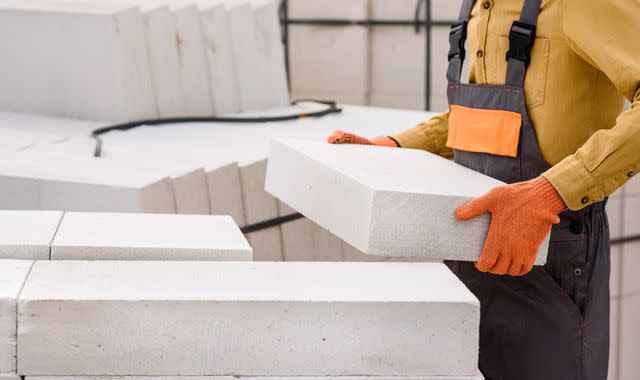Hospitals, courts and a shopping centre: Which other buildings are at risk of concrete collapse?

Unsafe concrete has been found in hospitals, courts and a shopping centre - as well as the 156 schools already identified in England.
The government announced on Thursday that a further 104 education "settings" have been identified as having reinforced autoclaved aerated concrete (RAAC) - as well as the 52 already investigated this year.
RAAC is a cheap, lightweight, 'bubbly' material that was used in construction between the 1950s and 1990s, when a report found structural deficiencies mean it only has a lifespan of around 30 years. It was mostly used for flat roofs - but also in walls and floors.
Investigations were stepped up in 2018 when the roof of a primary school in Gravesend, Kent collapsed without warning.
Now, with schools across the country at risk of closure - RAAC is being discovered in hundreds of buildings.
And a report by the Collaborative Reporting for Safer Structures warns that it was used "not only for schools, hospitals and other public buildings such as police stations… there is no reason why it could not have been used in many other buildings, both public and private".
Hospitals
NHS providers have identified 14 of its hospitals, which were constructed "either wholly or in major part with RAAC". Seven of these are considered "critical" and not fit for purpose beyond 2030.
As part of its 2019 manifesto, the government had already pledged to build 40 new hospitals.
After the assessment identified the RAAC sites, seven were added to that list and will be "rebuilt completely using a standardised design known as Hospital 2.0".
They are: West Suffolk Hospital, James Paget University Hospital, Airedale General Hospital, Queen Elizabeth Hospital King's Lynn, Hinchingbrooke Hospital, Mid Cheshire's Leighton Hospital, and Frimley Park Hospital.
In Wales, an internal major incident was declared at Withybush Hospital in Pembrokeshire after RAAC was found in three wards. These have been closed and patients relocated to other health board locations in the area.
Four office buildings, part of the restaurant and chapel were closed at Nevill Hall Hospital in Abergavenny after RAAC was identified there. No patients have been affected, the health board said.
The material was also found in a "limited part" of Bronglais Hospital in Ceredigion.
In Scotland, 254 hospital buildings are under investigation, which could take up to eight months.
This includes 53 from NHS Grampian, 44 from Greater Glasgow and Clyde, 35 from Lothian, 25 from Highland, 22 from Fife, eight from Forth Valley, and seven from the Borders.
Major sites such as Queen Elizabeth University Hospital in Glasgow, University Hospital Crosshouse in Kilmarnock and Ninewell Hospital in Dundee are included in this tally.
The Scottish government says there is still "no evidence" that any of the buildings are unsafe.
Police stations
Three buildings operated by Police Scotland have been found to contain RAAC after an investigation of 65.
One of them was a vehicle garage in Edinburgh, which had planks in the roof. The other two require remedial work, according to the force.
Courts
Harrow Crown Court in northwest London has been closed for nine months while RAAC is removed and replaced.
Cases are being moved to nearby Wood Green, Hendon and Amersham.
His Majesty's Court and Tribunal Service is investigating five other court buildings after RAAC was found in 2% of the estate.
Prisons and defence
Prisons minister Damien Hinds commissioned a survey of the prison estate in May this year after the six court buildings above were identified as at risk.
The Ministry of Defence began its own probe around the same.
They said that of the 60,000 buildings, the number of training facilities and barracks being looked at was "in the hundreds".
Shopping centre
A report into public sector buildings by the Collaborative Reporting for Safer Structures found a 1975-built shopping centre having RAAC in the roofs of a number of its external storerooms and loading bays.
It doesn't name the centre, but warns that RAAC was originally available to buy on the open market - so is likely to have been used for buildings in both the public and private sector.
Schools
Some 52 schools in England have already been disrupted this year due to the discovery of RAAC. On Thursday, the government added 104 to the list.
In Scotland, a freedom of information request revealed in May that at least 37 schools were built with some RAAC.
There are nine in Dumfries and Galloway, seven in Aberdeen, six in Clackmannanshire, five in West Lothian, two in Dundee, as well as others in wider Aberdeenshire, Argyll and Bute, East Lothian and Perth and Kinross.
Read more:
Some schools still not yet contacted
How will I know if my child's school is closing?
The Scottish government said it is taking the issue "very seriously". Schools found to have RAAC will receive "appropriate mitigation plans".
Following the announcement about schools in England, the Welsh government began its own investigation, but said in a statement: "Local authorities and further education institutions have not reported to us any instances of RAAC being present within schools or colleges."
Authorities in Northern Ireland have also commissioned structural surveys of schools there.


